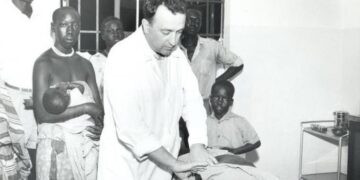We are in the months of July and August where in most of the dioceses in Uganda new priests are ordained. These celebrations bring along with them a wealth of joy and excitement to the faithful as they receive new priests and shepherds: “men appointed to act on behalf of men in relation to God, to offer gifts and sacrifices for sins.” (Catechism of the Catholic Church 1539). The excitement of the people to receive the newly ordained is based on the fact that the priest is the intermediator between them and God. That is, through the holy sacrifice of mass, the priest makes an offering to God for himself and for the people.
Through the sacrament of holy orders, the priests receive the grace to be ministers of Christ among the people. Thus, they become the dispenser of Gods graces through the sacraments which they celebrate for the people. It is not given to the perfect although it demands an utter response to the call to perfection and holiness just as the father is holy (1 Peter 1:16). Herein, I venture into the essence of priesthood and its contracting challenge of clericalism with the purpose of bringing to understanding the image of the priest in the Church and the present day image of the priest from the perspective of the lay faithful.
The priest, mediator and intercessor
Right from the Old Testament, the priest is presented as the bridge between God and the people. Just like Moses and Aaron, (Exodus 28:1-29:9 Hebrews 5:4) the role of the priest also entails governing and sanctifying the people of God. Literally, priests are the leaders of the people of God and example to them of what God desires and wants to lead his people into. The responsibility of sanctification of the people is paramount in the life of the priest. Also, like Aaron and Melchizedeck, who presented offerings for different purposes, forgiveness of sins, for thanksgiving, for the needs of the people and all the others as necessity dictates. Thus, the priest stood on the altar, the place of sacrifice and offered the gifts of the people to God, reconciling them to God and participating in their sanctification. In this, the priest is also an intercessor, invoking God’s mercy upon the people. He does this for himself and for the sins of the people.
Priesthood in the Church today is still rooted on this tradition and purpose. In the ordination prayer said by the bishop, it is well stipulated that; “Together with us, may he be a faithful steward of your mysteries, so that your people may be renewed in the waters of rebirth and nourished from your altar; so that sinners may be reconciled and the sick raised up. May he be joined with us, Lord, in imploring your mercy for the people entrusted to his care and for all the world.” In this prayer emerge more of the roles of the priest; teaching and keeping the mysteries, bringing renewal and nourishment to the people, reconciling sinners with God and bringing healing to the sick.
All these roles are related to the other sacraments that he celebrates: Rebirth through baptism, reconciliation through penance, nourishment through the Eucharist and healing of the sick through the anointing of the sick. It is the priest’s role to pray for the people, to present them to God through his offering of prayers and sacrifice of mass which he offers. Priesthood is therefore a gift, a mission and a ministry. It is a sign of God’s grace given to a person for the service of the people of God. The priest is the minister of God consecrated, set apart for the service of the people of God. So a priest is simply a servant of the people of God.
Clericalism
Contrary to the above image of the priest as servant, mediator is the attitude of clericalism, which is a presentation of the priesthood and the priest in a way that is contradictory or overrated to what it should actually be. According to Pope Francis, clericalism arises when the clerics feel superior and when they are far from the people. This according to the Pope can be fostered by the priests themselves or by the lay persons.
The dignity of the priesthood must not make the priest feel that he is autonomous and can decide anything on behalf of the people of God under his care, although by his good example, he can influence. Unfortunately, often, this is the image the faithful project on the priest, putting him on a pedestal and seeing him as “a know all person” and the measure. And because of this, rather than the priest being the servant of the people, the people become the servants of the priests.
Clericalism can also manifest itself in the attitude of the priest whose expectation from the people fills him with pride, prestige and a sense of being superior to everyone else. This betrays the humility and service that the priest is called to exude in his ministry. The life of the priest must be conformed to the life of Christ and the mystery of the cross which is inseparable from it. He must become the alter Christi, portray the mind and heart of Christ through his life (Philippians 2:5-11).
Therefore, in living the priesthood by the priest and understanding it by the faithful, it is important to return to the essentials and embrace them; that is; service rendered in humility for God’s people and the call to holiness that also sanctifies the people of God and reconciles them to him. Through dwelling in the presence of the Lord, the priest returns to what he is supposed to be.
By Fr. Nicholas Onyit MCCJ
















